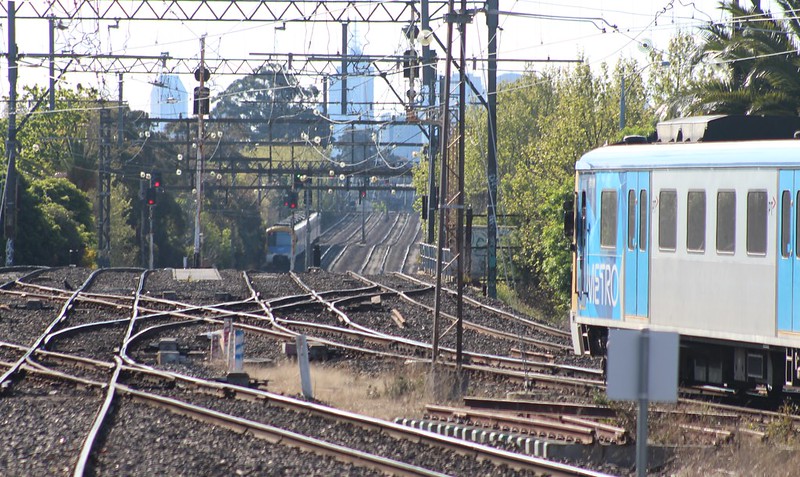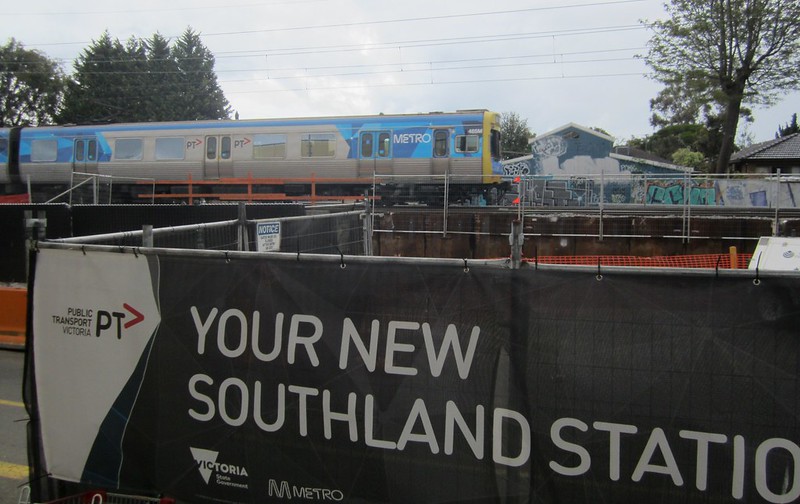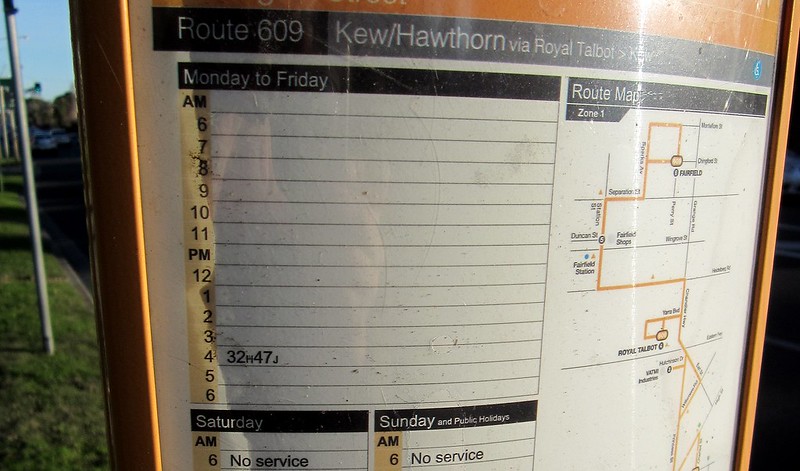Here’s a thought, via a possibly dodgy analogy: public transport is like a computer. It needs both hardware and software to function properly.
Hardware — right of way (tracks/roadspace), signalling, stops and platforms, vehicles, stabling.
Software — how do you operate it? Timetables, routes (particularly for buses, which can be easily changed), traffic light priority, staff.
People often forget that infrastructure alone won’t do it. A train line is of limited use unless the trains come frequently.
It’s amazing for example when reading in Wikipedia about a city’s rail system, that it often talks in detail about the lines and stations and fleet, but often doesn’t mention anything to do with operating hours or service frequencies, which are absolutely fundamental to how and whether people can use the system to get around efficiently.
Roads aren’t really like that. They can tweak the road rules and the traffic lights, but fundamentally the authorities supply the hardware. The users bring some of their own hardware (their vehicle) and software (decide when they travel, and which route).
But public transport needs both hardware and software working well to be really useful.
Of course just like in the world of computers, the hardware/infrastructure may impose a limit on the software/service that can be provided. Which means when buying or building the infrastructure, you need to plan what service will be provided on it, from day one and into the foreseeable future.
Funding
Hardware tends to be a once-off cost, aka Capital Expenditure (CapEx). Splash out for infrastructure, then in theory it lasts forever… It doesn’t really — maintenance is important. One rule of thumb I’ve heard is that for road infrastructure, 1% per year of the initial cost is needed for maintenance.
Software (in a transport context) is a recurring cost, aka Operating Expenditure (OpEx). The cost of running the train needs to be paid each time you run it: power, vehicle maintenance, and often the biggest component: staff. This is a bit different from the world of computers, though many software vendors now offer per month or per year licencing options, with free upgrades included, and in the world of the cloud, Software As A Service is getting very popular.
To stretch the analogy perhaps too far, public transport software (timetables) needs regular upgrades! Hardware too, but less often.
Who’s better at what?
I’d be cautious about generalising, but if you had to, you might say that each of our two major political parties are better at one or the other.
Labor seems to be better at hardware. Since about 2005 they’ve funded numerous upgrades to stations, got started on removing lots of level crossings, upgraded trains (ever notice how the Comeng fleet rarely breaks down in the heat nowadays?), expanded train and tram fleets, extended lines, even initiated an entirely new line (Regional Rail Link).
But Labor have been very cautious on upgrading timetables in recent years, perhaps because it often means changes that benefit many may also (slightly) disadvantage specific groups of users — to the extent that some of the new trains are sitting doing nothing waiting for the next change — while the fleet expands, it’s now been more than two years since the last major train timetable change.
Even minor tram route changes have been postponed, though the Metro rail tunnel is likely to force their hand.
The Coalition seems better at software. The 10 minute train services on the Frankston, Dandenong, Ringwood (the latter weekends only) and Newport (weekdays only) started on their watch (though the timetable change process may have started under Labor).
The Coalition also initiated PTV and their role in co-ordinating train and bus timetables, something which has since rolled out across many areas of Melbourne. Back in 2009 this was a memorable blind spot for Labor, though by 2010 they were acknowledging the problem.
But when the Coalition has been in power in recently (2010-2014), they haven’t done as much as Labor in terms of hardware. During that term, they ordered some new trains, but I’d struggle to think of other major public transport infrastructure they initiated. They successfully managed projects like South Morang rail and Regional Rail Link, but they’d been started by Labor. Southland station went nowhere. Their 2010 pledges for rail to Doncaster and Rowville resulted in studies that virtually ruled them out. Avalon airport rail link never happened. They made promises in 2014 for a rail tunnel and Melbourne Airport rail, but were voted out.
One could perhaps theorise that a deep-seated traditional conservative principle is coming into play: making the most of the assets you already have.
You don’t have to look too hard to see these generalisations fall down. Labor presided over the extension of trains and trams to 1am on weekends back in 2006, and this year have introduced Night Network, both of which make use of existing infrastructure to extend service hours — they also did numerous train timetable changes last decade, including moving weekday Werribee trains out of the Loop to make better use of the infrastructure, and did a massive review of bus routes in 2010, though most recommendations were never implemented.
The Coalition in their 2010-2014 term kicked off the Ringwood station upgrade, and funded some level crossing removals, giving us brand new stations at Mitcham and Springvale.
Without services, PT is nothing
Ultimately you need both the infrastructure and the services to be up to scratch for public transport to be useful.
Hopefully both sides of politics are getting better at both. Investment in better hardware is important, but so is tweaking the software to make the most of the available hardware.
Service quality varies widely across the network. Sometimes for good reasons related to demand, but sometimes just due to accidents of history.
Miss a bus on route 601, you’ll wait 4 minutes for the next one. On route 609, it might be 24 hours.
Miss a tram on route 86 in the middle of a weekday, you’ll wait 8 minutes for the next. On route 82, it’ll be 20 minutes.
Waiting at Melton station on a weekend? It’s 60 minutes between trains. At Mordialloc? 10 minutes.
A line on a map, or infrastructure on the ground means nothing unless the timetable is up to scratch.
And those of us who advocate for more public transport need to remember — services are just as important as infrastructure.




18 replies on “Public transport is like a computer. It needs both hardware and software”
Another “software” issue is the too often incorrect message (audio and on LCD display) as the train arrives at a station. No this station is not South Yarra, it’s Prahran! I feel sorry for non-locals or those who can’t speak English being very confused.
Having travelled on the undergrounds in London, Lyon and LA this year, the station name announced was always correct. Why can’t Metro do this in Melbourne?
I’ll give the current government some props for the software/services that they have rolled out or trialled rather quickly compared to what Government departments usually do. Things like the quick…er myki top up, updated gates and machines, trial paywave versions, route info onboard b class trams, new regional and metro pids to name a few.
That said, I would like to see clearer communication of proposed changes compared to the current hush hush methods due to “contract obligations/negotiations”, or even a regular cycle of changes such as every four months roll out the updates or roll back if not working.
I hope the updated website takes care of that and also caters to many more channels to effectively communicate messages to a far greater audience. Melbourne has a high concentration of other primary spoken languages, I think it’s time we embrace that more.
This is a great analogy and a good summary of how politics plays in this space. It also comes into play when decisions about funding infrastructure are being made. For example East West Link and Melbourne Metro had a similar capex spend. The road had minimal opex whereas the rail was tens or hundreds of millions a year. BCR becomes irrelevant in the face of high opex needed to actually run the asset.
I believe this problem skews funding decisions away from PT as governments are reluctant to sign up to high levels of ongoing opex. As a policy decision how could this opex balance be shifted so that this is less of a factor in determining what projects get built? Higher fares to improve cost recovery? Road pricing? Food for thought…
I think a good way to look at it is that ‘software’ or service is the key goal. Having more services and more capacity is what the system is aiming for.
Hardware and infrastructure is provided to improve capacity available for service, but by itself it does not do much.
You can upgrade your track and signalling as much as possible, but if it does not result in service improvements, it is of no value.
After 10pm on a weekday, if you want to travel one stop from Parliament to Richmond, there are three trains in 6 minutes, then none for 24 minutes. It would cost nothing to spread these trains out to provide a more useful and usable service.
After 10pm on a weekday, trains to Caulfield and Burnley operate on a ~6/24 minute cycle. Again, changing this to 15/15 would cost nothing and add a lot of benefit.
http://www.ptua.org.au/2012/06/04/potd-poor-timetabling/ It’s sad that this was written 4.5 years ago, still applies and could be fixed so easily.
Regional Rail Link was ready in April last year (opening delayed for 2 months because somebody forgot to order enough trains!) and allows the Werribee line to have a large increase in services, but virtually nothing has been done to take advantage of this capacity.
Reportedly the new timetable was delayed indefinitely just because it was proposed that all Frankston line trains would be taken out of the loop. Sandringham passengers have had direct weekday services for years and the world hasn’t fallen in.
Treat the public intelligently by explaining that:
-The current Frankston loop frequency during weekday PM peak is ~11 minutes
-None of these services run express
-Many of these services terminate short of Frankston, so an interchange is common already
-2-3 Dandenong trains (which all run express South Yarra-Caulfield) run between these Frankston services, which will possibly allow a connection to an earlier Frankston service at Caulfield (definitely if the Frankston services are replaced with Dandenong services)
-Having no Frankstop loop services would force a change of behaviour, which for a passenger who doesn’t know the full ins and outs of the timetable, means an average reduced wait time of 1-2 minutes rather than 5-6 minutes, a trip to Caulfield reduced by 5 minutes, and a choice of stopping pattern once they get there
^ In addition to your example Nick, try catching a train to Footscray after 10pm, it’s a 2/28 minute cycle on weeknights.
I’ve noticed in Melbourne that the “software” as in timetables seems to be relatively set in stone compared to other cities. The bus network is the best example – other cities (even Adelaide or Canberra) have annual reviews and network re-shuffles. Isn’t there a need to re-assess what funding is used for?
They’ve been improving in recent years, with things like the twice weekly route 479 extension to the City (another great contender for most useless bus route!) being removed, but things like route 745 still exist, which is a collection of four routes that run once per day in one direction only, and generally run completely empty:
https://static.ptv.vic.gov.au/siteassets/Maps/Routes/PDFs/957_Bus745.pdf
It’s a bit like the farcical situation that existed for years (now finally fixed!) where public holiday bus services varied hugely – some ran a Saturday T/T, some ran a Sunday T/T, some normally ran 7 days but didn’t run at all. Until very recently there was still the anomaly that full time bus routes would run a Saturday timetable on PHs, but bus routes that only operate Monday – Saturday wouldn’t run at all. Way to confuse people!
There are also a lot of things that don’t fall into either the hardware or software category that could help the system enormously if anyone bothered to consider them.
Just a couple of examples:
1. Public holiday timetables on days such as Cup Day. OK I know this is a public holiday for most people, but the trains are heavily used by race goers, and also the thousands of Uni students (and staff) who have not had this day as a public holiday for as long as I can remember. And consider that since this is exam period, Uni students are nearly all trying to get to exams on Cup day. The trains going to Caulfield (with Monash Uni exams being held at the racecourse) are nearly all as full as ever despite the holiday.
2. Inefficiencies due to location of myki readers. This is especially an issue at stations such as Caulfield, where people changing from the two centre platforms to the outer platforms have to touch off along with the crowds exiting the station, and then run down the ramp and up another one only to touch on again for platforms 1 and 4. All this adds time and increases the likelihood of missing connections, especially when you have to also fight against the crowds entering the central platforms at the same time. This isn’t an as big an issue at South Yarra and Richmond, two other stations with lots of people changing platforms, as you only need to touch off when you completely exit the station (there are other issues at South Yarra though in terms of people movement, especially the congestion at the station entry and overflow onto Toorak Rd). The situation at Caulfield needs a rethink.
How does Melbourne’s staffing situation affect all of this? I see that there have been issues with the RTBU which seem to complicate operations compared with other cities and countries (where staff are hired, paid a good wage and given decent conditions, and the operator retains control of the system).
Remember the biggest driver for any political party. Votes. They will only do things to Public Transport if there are votes in it. Sorry to say, but waiting 60 minutes for a train at Melton – there are not that many votes to gain if that was fixed.
Good analogy, and well written in that respect.
Does this make the Transit Officers and the PTOs both the antivirus system?
Following the daytime and weekend frequency change from services every 20 minutes to every 10 minutes on services to Ringwood, Dandenong and Frankston, do you think patronage has increased or a similar number of passengers spread more thinly ? From my limited observations on the Dandenong route, weekend patronage seems quite healthy with 10 minute frequencies as if patronage has increased substantially.
Minimum standards upgrade right across Melbourne have to be one of the biggest “software” upgrades in recent decades, along with SmartBus (which was a combination of both) and both happened under ALP. But then again, they were also the same party to cut bus services in 1991.
Liberals gave us the premium stations upgrades in the 90s alongside interpeak upgrades on the Caufleild group and Sunday upgrades on all trains lines and trams.
Minimum standards is a farce. It simply doesn’t happen because the government never enforces the rules. Why are standard (not “coverage”, “peak” or “school”) suburban bus routes allowed to start at 8AM (or even later), finish at 5PM (or even earlier) and not run on Sundays or even Saturdays in some cases? If Metro did that with the Alamein, Cranbourne or Williamstown lines out of the blue to cut costs World War 3 would be declared! Bus routes should either be upgraded to the “standard” of 6AM to 9PM (which really should be changed to 5AM-11PM/midnight to match the trains and trams) seven days or scrapped entirely.
Today is a Tuesday. Normally, my 742 bus starts at 6AM and finishes at just after 9PM like a normal everyday mediocre bus. But because it’s suddenly Saturday, it gets to sleep in until 8AM and finish about twenty minutes earlier. Move across to the recently-upgraded route 380 loop service (in reality, a fancy new number for routes 366 and 367 which does nothing but create confusion, not to mention all buses have Ringwood on the front at all times even when they are going to Croydon). That one runs very frequently during the day and finishes at around 10PM-11PM. But because it’s suddenly a Saturday timetable on the 27th due to the government still pushing their outdated religious-minority beliefs on everyone (face it, they aren’t putting on a public holiday while making it illegal to do normal paid work outside of hours dictated by the government on the 25th of December because Santa Claus is coming to town), it now runs once an hour until 8:48PM. On the Sunday timetable, it finishes at only 6:48PM for no given reason (shock horror, this is actually an *improvement* from the 366/367 Sunday timetables, which unbelievably had one bus every two hours from 8AM until 4PM).
[…] certainly not as simple as saying Labor’s good at PT while the Coalition is bad. (Indeed, one sweeping and partly flawed generalisation is that Labor is better at infrastructure, and the Coalition is better at […]
[…] Daniel Bowen reflects on ‘Liberal vs Labor’ thinking in public transport […]
[…] public transport, “software” — routes and operating hours and frequencies that meet passenger needs, is […]
[…] it does give some oxygen to a theory Daniel Bowen came up with back in 2016 – Labor seems to be better at building new public transport infrastructure, while the the […]